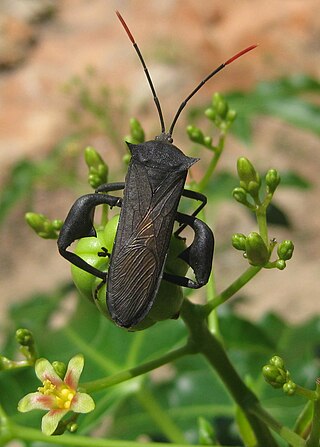
Pentatomidae is a family of insects belonging to the order Hemiptera, generally called shield bugs or stink bugs. Pentatomidae is the largest family in the superfamily Pentatomoidea, and contains around 900 genera and over 4700 species. As hemipterans, the pentatomids have piercing sucking mouthparts, and most are phytophagous, including several species which are severe pests on agricultural crops. However, some species, particularly in the subfamily Asopinae, are predatory and may be considered beneficial.

Coreidae is a large family of predominantly sap-sucking insects in the Hemipteran suborder Heteroptera. The name "Coreidae" derives from the genus Coreus, which derives from the Ancient Greek κόρις (kóris) meaning bedbug.

Pentatominae is a subfamily of Pentatomidae, a family of shield bugs. This subfamily is the largest one within the Pentatomidae, having 4937 species classified in 938 genera. Species in this subfamily are phytophages and several of them are considered agricultural pests. Some invasive pentatomines such as Halyomorpha halys and Bagrada hilaris have been considered household pests. Higher systematics of the group have been revised by Rider et al.

Asopinae are a subfamily of stink bugs. They are predatory stink bugs that are useful as biological control agents against pests, even against other Pentatomid species, which are all herbivorous.

Alydidae, commonly known as broad-headed bugs, is a family of true bugs very similar to the closely related Coreidae. There are at least 60 genera and 300 species altogether. Distributed in the temperate and warmer regions of the Earth, most are tropical and subtropical animals; for example Europe has a mere 10 species, and only 2 of these occur outside the Mediterranean region.

Ricaniidae is a family of planthopper insects, containing over 400 species worldwide. The highest diversity is in tropical Africa and Asia and in Australia, with a few species occurring in the Palearctic and Neotropical realms. It is one of the smaller families in the planthopper superfamily Fulgoroidea.

Coreinae is a subfamily in the hemipteran family Coreidae. They have been shown to be paraphyletic with respect to Meropachyinae.

The Harpactorinae are a large subfamily of the Reduviidae. About 300 genera and 2,000 species worldwide have been described. Some of the species of the genera Zelus, Pselliopus, Sinea, and Apiomerus are of interest as biological pest control agents.

Harpactorini is a tribe of the Harpactorinae. This group is the most diverse of the entire assassin bug family, with 51 genera recognized in the Neotropical Region and 289 genera and 2003 species overall.

Mezirinae is a subfamily of flat bug. It is distributed globally. The subfamily contains more than 1120 described species in 124 genera.

Rhopalinae is a subfamily of scentless plant bugs in the family Rhopalidae. There are more than 170 described species in Rhopalinae.

Pentatomini is a tribe of shield bugs in the subfamily of Pentatominae.

Cydninae is a subfamily of burrowing bugs in the family Cydnidae. There are about 11 genera and at least 40 described species in Cydninae.

Podopinae, known as turtle bugs, are a subfamily of the insect family Pentatomidae. The type genus is Podops.

Carpocorini is a tribe of stink bugs in the family Pentatomidae. There are more than 100 genera in Carpocorini.
Meropachyinae is a subfamily of leaf-footed bugs in the family Coreidae. There are at least 50 described species in Meropachyinae, recorded from the Americas.

The Phyllocephalinae are a subfamily of shield bugs erected by Amyot and Serville in 1843.

The Mictini are a tribe of leaf-footed bugs, in the subfamily Coreinae erected by Amyot & Serville in 1843. Genera are distributed from Africa to South-East Asia.

The Homoeocerini are a tribe of leaf-footed bugs, in the subfamily Coreinae erected by Amyot and Serville in 1843. Genera are distributed from Africa to South-East Asia.



















